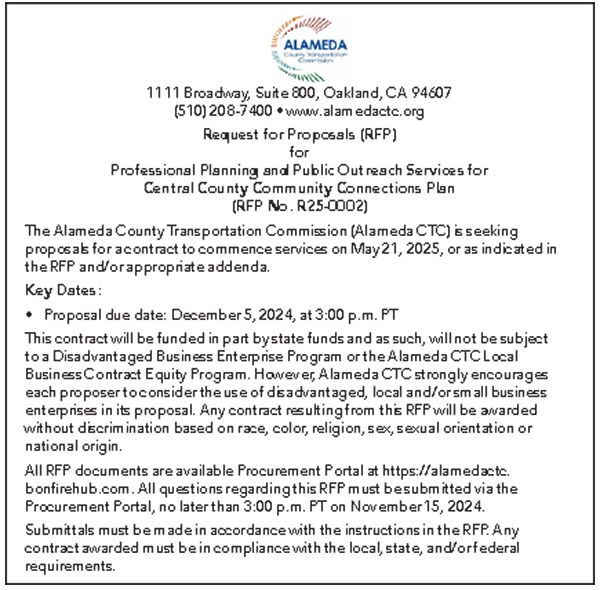Environment
Residents Support Water Cutbacks, Worry About Rate Increases
A recent Field poll indicates that 65 percent of Californians support Governor Jerry Brown’s mandatory 25 percent reduction of water use in urban areas.
At the same time, seven out of 10 homeowners say that it would be a “serious problem” if their water bill increased by 15 to 25 percent.
East Bay Municipal Utility District (EBMUD) customers have already been asked to reduce their water use by 20 percent, with a goal of 35 gallons per day, per person, for indoor use.
Residential water use accounts for around 68 percent of EBMUD’s water demand, while commercial use is around nine percent, and around 11 for industrial, according to Nelsy Rodriguez, spokesperson for EBMUD.
Current demand is going down because of conservation and is around 151 million gallons per day.
Also, a surcharge will be discussed by the EBMUD Board of Directors on June 9, and if approved, will go into effect July 1. The temporary surcharge would be removed if the EBMUD board decides the drought is over, according to Rodriguez.
Rodriguez went on to explain that about 100 people have protested the surcharge, using Proposition 218.
Prop 218 was passed in 1996, and requires local governments to have a vote when considering any new taxes on property owners. The law recently gained traction in April when a California Court of Appeals said that the law extends to water municipalities.
Residents in Morada, a small town just north of Stockton, protested against increased water rates. Prop 218 allowed the town to keep water costs at a flat rate, as long as the majority of customers protested the hike.
However, the same Field report also indicates that 57 percent of California residents believe that agriculture can reduce water consumption without hardships.
In an interview with the Post, Dr. Peter Gleick, founder of Oakland based Pacific Institute, said: “The biggest source of water out there is the water that we waste every day, doing the things that we do. A lot of the water we use now can be used more effectively. We could grow more food with less water, with better irrigation technology. And we could supplement that with more efficient toilets and washing machines at home. That’s probably the biggest source of untapped water, is the water that we’re wasting.”
Gleick went on to explain that “in the short run, individual behavior plays a significant role during droughts, because it takes time to implement new policies or technologies. But in the long run, changes in technology will be very important. We have a short term drought, and a long term water problem.”
Looking at possible solutions, Gleick said, “We treat waste water, and treat it to a fairly high standard, and then dump it into the ocean. But now there’s more of an effort to put that waste water to re-use. For instance, we use recycled waste water for our office landscaping.”
“We need to expand our storage capacity, but there are innovative ideas around groundwater storage,” he continued. “We over-pump our groundwater now, but we could be refilling those aquifers during rainy years.”
“There are proposals for conjunctive use – it’s the joint management of surface water and ground water together, and I think that offers far more potential than any new surface storage,” Gleick added.
“The reason the idea is so appealing is that it doesn’t require any more damage to rivers, and water isn’t lost to evaporation. I think the concept has great potential,” he said.
A recent Field poll indicates that 65 percent of Californians support Governor Jerry Brown’s mandatory 25 percent reduction of water use in urban areas.
At the same time, seven out of 10 homeowners say that it would be a “serious problem” if their water bill increased by 15 to 25 percent.
East Bay Municipal Utility District (EBMUD) customers have already been asked to reduce their water use by 20 percent, with a goal of 35 gallons per day, per person, for indoor use.
Residential water use accounts for around 68 percent of EBMUD’s water demand, while commercial use is around nine percent, and around 11 for industrial, according to Nelsy Rodriguez, spokesperson for EBMUD.
Current demand is going down because of conservation and is around 151 million gallons per day.
Also, a surcharge will be discussed by the EBMUD Board of Directors on June 9, and if approved, will go into effect July 1. The temporary surcharge would be removed if the EBMUD board decides the drought is over, according to Rodriguez.
Rodriguez went on to explain that about 100 people have protested the surcharge, using Proposition 218.
Prop 218 was passed in 1996, and requires local governments to have a vote when considering any new taxes on property owners. The law recently gained traction in April when a California Court of Appeals said that the law extends to water municipalities.
Residents in Morada, a small town just north of Stockton, protested against increased water rates. Prop 218 allowed the town to keep water costs at a flat rate, as long as the majority of customers protested the hike.
However, the same Field report also indicates that 57 percent of California residents believe that agriculture can reduce water consumption without hardships.
In an interview with the Post, Dr. Peter Gleick, founder of Oakland based Pacific Institute, said: “The biggest source of water out there is the water that we waste every day, doing the things that we do. A lot of the water we use now can be used more effectively. We could grow more food with less water, with better irrigation technology. And we could supplement that with more efficient toilets and washing machines at home. That’s probably the biggest source of untapped water, is the water that we’re wasting.”
Gleick went on to explain that “in the short run, individual behavior plays a significant role during droughts, because it takes time to implement new policies or technologies. But in the long run, changes in technology will be very important. We have a short term drought, and a long term water problem.”
Looking at possible solutions, Gleick said, “We treat waste water, and treat it to a fairly high standard, and then dump it into the ocean. But now there’s more of an effort to put that waste water to re-use. For instance, we use recycled waste water for our office landscaping.”
“We need to expand our storage capacity, but there are innovative ideas around groundwater storage,” he continued. “We over-pump our groundwater now, but we could be refilling those aquifers during rainy years.”
“There are proposals for conjunctive use – it’s the joint management of surface water and ground water together, and I think that offers far more potential than any new surface storage,” Gleick added.
“The reason the idea is so appealing is that it doesn’t require any more damage to rivers, and water isn’t lost to evaporation. I think the concept has great potential,” he said.
Bay Area
Chevron Richmond Installs Baker Hughes Flare.IQ, Real-time Flare Monitoring, Control and Reduction System
While the sight of flaring can cause concern in the community, flares are essential safety systems that burn pollutants to prevent them from being released directly into the atmosphere. They activate during startup and shut-down of facility units or during upsets or equipment malfunctions. The typical flare stack is about 200 feet high so that vapors are well above street levels.

The Richmond Standard
Chevron Richmond recently installed flare.IQ, a real-time, automated system that will improve the facility’s flaring performance.
The technology, developed by Panametrics, a Baker Hughes business, uses sensors to monitor, reduce and control flaring in real time. It collects and assesses data on refinery processes, such as temperature, pressure, gas flow and gas composition, and adjusts accordingly to ensure flares burn more efficiently and cleanly, leading to fewer emissions.
“The cleaner the flare, the brighter the flame can look,” said Duy Nguyen, a Chevron Richmond flaring specialist. “If you see a brighter flame than usual on a flare, that actually means flare.IQ is operating as intended.”
While the sight of flaring can cause concern in the community, flares are essential safety systems that burn pollutants to prevent them from being released directly into the atmosphere. They activate during startup and shut-down of facility units or during upsets or equipment malfunctions. The typical flare stack is about 200 feet high so that vapors are well above street levels.
“A key element in Baker Hughes’ emissions abatement portfolio, flare.IQ has a proven track record in optimizing flare operations and significantly reducing emissions,” said Colin Hehir, vice president of Panametrics, a Baker Hughes business. “By partnering with Chevron Richmond, one of the first operators in North America to adopt flare.IQ, we are looking forward to enhancing the plant’s flaring operations.”
The installation of flare.IQ is part of a broader and ongoing effort by Chevron Richmond to improve flare performance, particularly in response to increased events after the new, more efficient hydrogen plant was brought online in 2019.
Since then, the company has invested $25 million — and counting — into flare minimization. As part of the effort, a multidisciplinary refinery team was formed to find and implement ways to improve operational reliability and ultimately reduce flaring. Operators and other employees involved in management of flares and flare gas recovery systems undergo new training.
“It is important to me that the community knows we are working hard to lower emissions and improve our flaring performance,” Nguyen said.
Also evolving is the process by which community members are notified of flaring incidents. The Community Warning System (CWS), operated by Contra Costa County is an “all-hazard” public warning system.
Residents can opt-in to receive alerts via text, e-mail and landline. The CWS was recently expanded to enable residents to receive notifications for “Level 1” incidents, which are considered informational as they do not require any community action.
For more information related to these topics, check out the resources included on the Chevron Richmond, CAER and Contra Costa Health websites. Residents are also encouraged to follow @chevronrichmond and @RFDCAOnline on Facebook and X (formerly Twitter), where additional information may be posted during an incident.
Activism
Asm. McKinnor Pushes Bill to Protect California Workers from High Heat, Other Climate Hazards
“Extreme heat is on the rise, with year-over-year, record-breaking temperatures that threaten the health and safety of California workers, from warehouse workers who lack adequate cooling, to janitors cleaning buildings after the air conditioning has been turned off, to line chefs cooking in unventilated kitchens,” McKinnor said at the rally.

By Antonio Ray Harvey, California Black Media
On May 6, employees from industries across the private and public sectors — including utility, domestic, janitorial, healthcare, oil and gas, and farm workers — joined educators and others in Sacramento to push lawmakers to strengthen the state’s health and safety enforcement systems.
The rally at the State Capitol was organized by a statewide coalition of 15 worker unions called California Labor for Climate Jobs (CLCJ).
Organizers say their campaign to pressure legislators and state officials to not abandon their responsibility to protect workers is urgent as climate hazards rise and federal government efforts to pull back on oversight and enforcement increase.
“Approximately 19 million workers in the state are here together to have a say in what happens next,” said Norman Rogers, vice president of United Steelworkers Local 675. “In seven of the last eight years, California has recorded record-high temperatures while workers from our state’s fields to our commercial kitchens, from our warehouses to our schools continue to work in dangerously high-heat conditions.”
Cal/OSHA provides protection and improves the health and safety of working men and women in the state. The agency also enforces public safety measures to protect passengers riding on elevators, amusement rides, tramways, and more.
According to a 2023 report by the American Federation of Labor and Congress of Industrial Organizations (AFL-CIO), workplace hazards are responsible for killing approximately 140,000 workers each year, including 5,283 from traumatic injuries.
Hazardous working conditions have caused an estimated 135,000 deaths from occupational diseases. That’s about 385 workers dying each day, according to the report.
Assemblymember Tina McKinnor (D-Inglewood) spoke at the rally to discuss legislation she authored, Assembly Bill (AB) 694, which proposes a pathway to jobs for Cal/OSHA to ensure stronger public safety enforcement.
According to CLCJ, Cal/OSHA is experiencing an understaffing crisis that is evident in the agency’s 43% vacancy rate.
McKinnor, a member of the California Legislative Black Caucus (CLBC), said the bill aims to fully staff the state agency with enforcement agents who have expertise in working in California’s most dangerous work environments.
The Assembly Committee on Higher Education voted 9-0 to advance AB 694 on April 29. It is now headed to the Committee on Appropriations for consideration.
“Extreme heat is on the rise, with year-over-year, record-breaking temperatures that threaten the health and safety of California workers, from warehouse workers who lack adequate cooling, to janitors cleaning buildings after the air conditioning has been turned off, to line chefs cooking in unventilated kitchens,” McKinnor said at the rally.
McKinnor continued, “We must urgently shore up our health and safety systems, so we can enforce California heat standards and safeguard worker health.”
CLCJ released the California Worker Climate Bill of Rights last fall, urging state legislators to propose policy solutions to protect workers from climate hazards such as extreme heat, fires, smoke, and floods.
Norman Rogers, Second Vice President of United Steelworkers Local 675 in Carson, said oil refinery operations around the state pose “the most hazards.
“AB 694 seeks to recreate Cal/OSHA to hire union oil and gas workers leveraging the knowledge, health and safety training, and process safety training used daily to ensure safe, compliant refinery operations,” Rogers added.
Activism
Gov. Newsom Approves $170 Million to Fast Track Wildfire Resilience
AB 100 approves major investments in regional conservancies across the state, including over $30 million each for the Sierra Nevada, Santa Monica Mountains, State Coastal, and San Gabriel/Lower LA Rivers and Mountains conservancies. An additional $10 million will support wildfire response and resilience efforts.

By Bo Tefu
California Black Media
With wildfire season approaching, last week Gov. Gavin Newsom signed Assembly Bill (AB) 100, unlocking $170 million to fast-track wildfire prevention and forest management projects — many of which directly protect communities of color, who are often hardest hit by climate-driven disasters.
“With this latest round of funding, we’re continuing to increase the speed and size of forest and vegetation management essential to protecting communities,” said Newsom when he announced the funding on April 14.
“We are leaving no stone unturned — including cutting red tape — in our mission to ensure our neighborhoods are protected from destructive wildfires,” he said.
AB 100 approves major investments in regional conservancies across the state, including over $30 million each for the Sierra Nevada, Santa Monica Mountains, State Coastal, and San Gabriel/Lower LA Rivers and Mountains conservancies. An additional $10 million will support wildfire response and resilience efforts.
Newsom also signed an executive order suspending certain regulations to allow urgent work to move forward faster.
This funding builds on California’s broader Wildfire and Forest Resilience Action Plan, a $2.7 billion effort to reduce fuel loads, increase prescribed burning, and harden communities. The state has also launched new dashboards to keep the public informed and hold agencies accountable.
California has also committed to continue investing $200 million annually through 2028 to expand this effort, ensuring long-term resilience, particularly in vulnerable communities.
-

 Activism4 weeks ago
Activism4 weeks agoAI Is Reshaping Black Healthcare: Promise, Peril, and the Push for Improved Results in California
-

 Activism4 weeks ago
Activism4 weeks agoBarbara Lee Accepts Victory With “Responsibility, Humility and Love”
-

 Activism4 weeks ago
Activism4 weeks agoESSAY: Technology and Medicine, a Primary Care Point of View
-

 Activism4 weeks ago
Activism4 weeks agoNewsom Fights Back as AmeriCorps Shutdown Threatens Vital Services in Black Communities
-

 Activism4 weeks ago
Activism4 weeks agoFaces Around the Bay: Author Karen Lewis Took the ‘Detour to Straight Street’
-

 Arts and Culture4 weeks ago
Arts and Culture4 weeks agoBOOK REVIEW: Love, Rita: An American Story of Sisterhood, Joy, Loss, and Legacy
-

 #NNPA BlackPress4 weeks ago
#NNPA BlackPress4 weeks agoThe RESISTANCE – FREEDOM NOW
-

 Alameda County4 weeks ago
Alameda County4 weeks agoOUSD Supt. Chief Kyla Johnson-Trammell to Step Down on July 1


















































